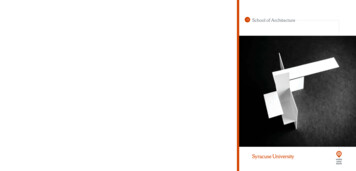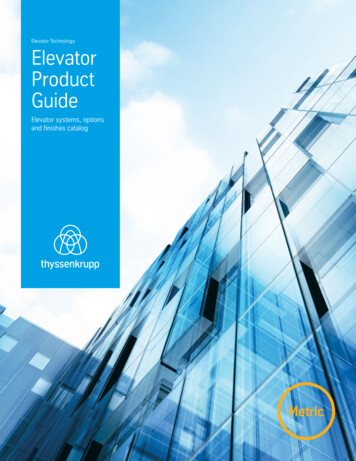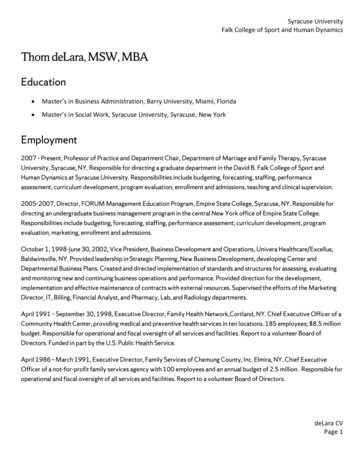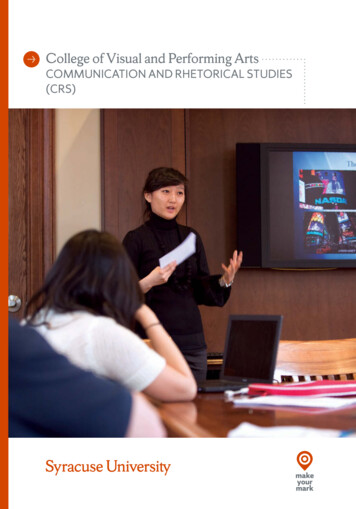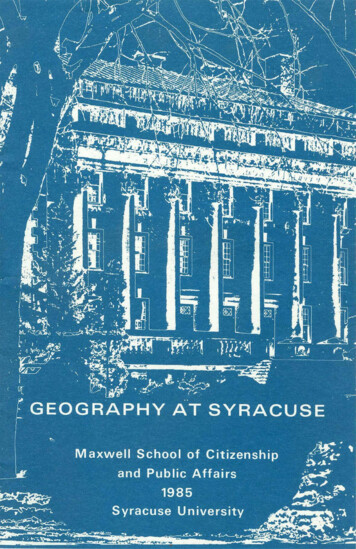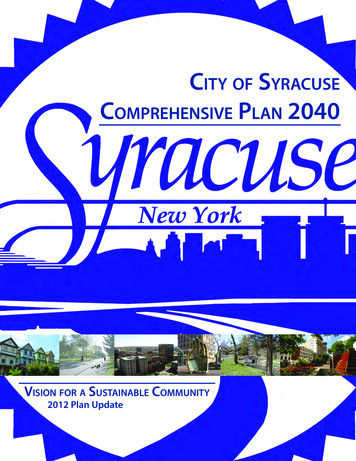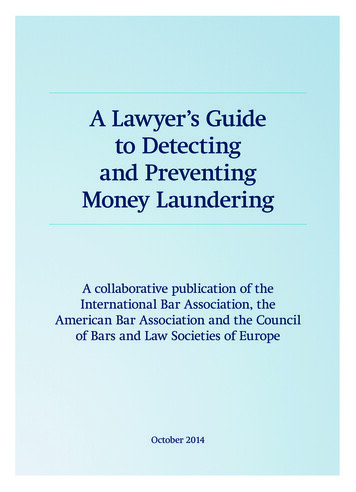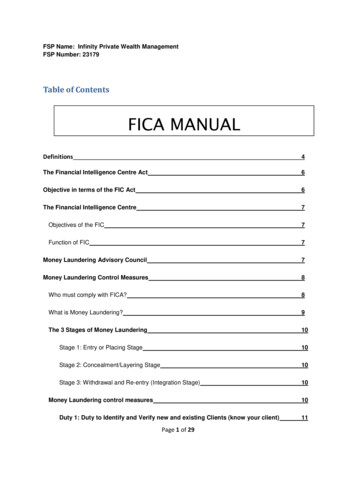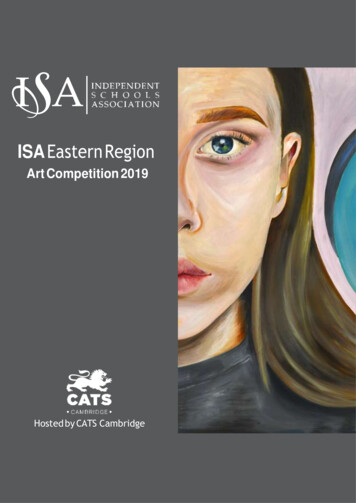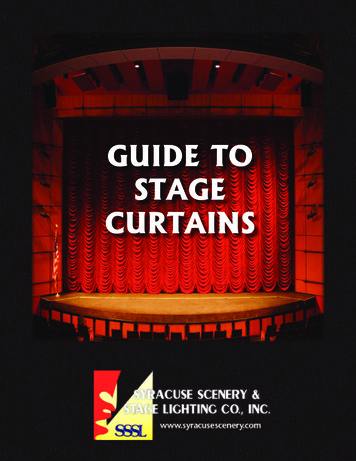
Transcription
GUIDE TOSTAGECURTAINS
SYRACUSE SCENERY & STAGE LIGHTING CO., INC.www.syracusescenery.com1101 Monarch Drive Liverpool, NY 13088-4514P: (315) 453-8096 800-453-SSSL F: (315) 453-7897 E: info@syracusescenery.com
GUIDE TO STAGE CURTAINSINTRODUCTIONStage Curtains are fabricated in every size and shape. The term stage curtain refers to any and all curtains that hang on (orsometimes near) a stage. Syracuse Scenery & Stage Lighting Co., Inc. specializes in manufacturing stage curtains. Stagecurtains are differentiated from other types of curtains by their stage function, by their size and fabric selection, and by theirfabrication specifications. Specifications for fabrication of stage curtains are numerous. In order to provide information to ourcustomers and potential customers, Syracuse Scenery offers a glossary of the terminology used in our work, a description ofsome of the more common fabrics used in the manufacture of stage curtains and our professional standard of fabrication.Syracuse Scenery & Stage Lighting Co., Inc. has been in the business of stage curtains for over 90 years. The company hasmanufactured curtains ranging from helicopter simulator cockpit covers, to the most decorative curtains for showrooms, as wellas stage curtains for thousands of schools, colleges and auditoriums in the United States and other countries.TYPES OF CURTAINSThere are many names used for stage curtains. SyracuseScenery first printed the above illustration in 1972 to showour customers the terms we use for various stage curtains.This simple illustration has been copied by fabric suppliersand other manufacturers, and has now become a standardin itself. This illustration shows a typical elementary orsecondary school stage curtain layout. Stages in elementaryand secondary schools serve many purposes. The curtainsare usually arranged so, without any other scenery, theaudience sees only what is occurring on the stage. The curtainarrangement enhances the background of the event occurringon the stage. In most colleges and universities, stages arepredominantly used for productions. In these facilities, thereis usually a Front Curtain and functional backdrops, scrims orcycloramas. Other curtains on the stage are used as masking,keeping the audience from seeing the functional parts of thestage and making the stage background disappear.For stages where the curtains are used as scenery, we use theterm “setting” to describe all of the curtains that are locatedSYRACUSE SCENERY & STAGE LIGHTING CO., INC.www.syracusescenery.com101 Monarch Drive Liverpool, NY 13088-4514P: (315) 453-8096 800-453-SSSL F: (315) 453-7897 E: info@syracusescenery.com2
layout of stage curtains in plan viewon a certain part of the stage and that are made of the samefabric or color.Each “setting” has predominant uses, but each facility canalso have its own specific uses for curtains and may have moreor fewer curtains than are illustrated.MAIN SETTING: The Main Setting usually functions asthe decorative closure of the stage area proper or the dividingline between the audience area and the stage area. In fabricand color, the Main Setting should enhance the appearanceof the auditorium and coordinate with the seating, carpetingand architectural details.The Main Traveler can open in the middle, or if space allows,it can be opened by lifting straight up. It can also do both.The curtain can also be raised by brailing. A brail curtaingathers up from the bottom using lift lines running throughrings sewn onto the backside of the curtain.Other names used for the curtains in the Main Settinginclude:MAIN TRAVELER - Act Curtain, HouseCurtain, Front Curtain, Grand Drape,Main Curtain, Proscenium CurtainMAIN VALANCE - Teaser, Proscenium ValanceMAIN LEGS - Tormentors, TabsOLIO SETTING: The term “Olio”, which is defined as amedley of tunes, is taken from the vaudevillian era when actson stage were performed in front of this curtain setting. TheOlio Setting is located anywhere from immediately behind theMain Setting to approximately the mid-stage area. The OlioSetting was historically gold and somewhat fancier than theother curtains. In modern usage, the Olio Setting is usually aneutral color to provide a backdrop for a speaker. If the MainSetting does not completely clear off the stage, the color ofthe Olio Setting should coordinate with the Main Setting.If the Olio Setting is used only for midstage masking, and isnot to be used to cut off the stage for a smaller playing area,the Olio Setting will usually be of the same fabric and coloras the Cyclorama Setting.Other names used for curtains in the Olio Setting include:OLIO TRAVELER - Speaker Curtain, MidstageTraveler, Midstage Cut-Off Curtain, 2nd CurtainOLIO VALANCE - Midstage Valance, MidstageTeaserOLIO LEGS - Tormentors, TabsCYCLORAMA SETTING: The Cyclorama Settingprovides the major masking on the stage. The purpose ofmasking curtains is to conceal the side walls, rear wall, andoverhead areas of the stage house from the audience view.SYRACUSE SCENERY & STAGE LIGHTING CO., INC.www.syracusescenery.com3101 Monarch Drive Liverpool, NY 13088-4514P: (315) 453-8096 800-453-SSSL F: (315) 453-7897 E: info@syracusescenery.com
The Cyclorama Setting is often used as scenery, providingan “invisible” background for presentations. The CycloramaSetting should be black when the stage is used mainly fordramatic presentations. Many elementary and secondaryschools use their stage areas primarily for band and choralpresentations. A lighter neutral color Cyclorama Settingwould be selected since it is desirable for the performers tostand out from the background. When the facility is usedequally for dramatic and musical presentations, having twosets of curtains is a desirable option. Where the budget doesnot allow for a second set of curtains, the decision on coloris usually left to the person most in authority (or with theloudest voice).Other names for curtains in the Cyclorama Settinginclude:Masking Curtains, Backstage Curtains,Rear Curtains and Backdrops.BACKDROP, SKYDROP, SCRIM: The Backdrop(natural/off-white color) or Skydrop (light blue color) isusually placed near the back wall and provides a surfacefor projecting scenery or lighting effects. The Backdropor Skydrop can be used alone to represent the sky. TheBackdrop or Skydrop is often referred to as a Cyclorama,especially if the curtain is mounted on a curved batten.the midstage area for special effect purposes. In order to bemost effective, careful lighting placement and choice of fixturesis essential. There are several varieties of scrim. The mostcommonly used scrim fabric is Sharkstooth Scrim.Backdrops and Scrims are often painted for effects or scenery.Backdrops and Scrims which are going to be painted shouldbe fabricated from plain, not flame retardant treated, fabric.A chemical reaction can occurbetween the flame retardantand the paint which causesunremovable white staining.Backdrops can be painted overseveral times using scenic paints.Scrims usually can not be repainted.illustration ofsharkstooth scrimweaveBackdrops are available bothseamed and seamless. When seamsare used, the preferred arrangement for the seams ishorizontal. The horizontal seams allow the eye to travelacross the curtain without the interruptions of vertical lines.Seamless Backdrops are more expensive, but a seamlesscurtain provides the best surface for lighting and allows formore realistic effects.Scrims and all but the tallest backdrops that are not going tobe painted can be fabricated from inherently flame resistantfabrics. These fabrics are more expensive. Typically scrimsand backdrops are replaced more frequently than otherstage curtains and the benefit of the fabrics not requiring retreatment for flame retardancy is less than for other curtains.AUSTRIAN, BRAIL, CONTOUR ANDTABLEAU CURTAINS:illustration of a seamed muslin backdropA Scrim curtain lighted only from the rear becomestranslucent and is used for shadow and special effects. Whenthe Scrim is lighted from the front, it becomes opaque andis often used as a Backdrop. In order to be effective, Scrimcurtains must be sewn without interior seams. Scrim fabricis available up to 36' in height. The Scrim is often placed inAUSTRIAN refers to the manner in which the curtain fullnessis arranged. BRAIL, CONTOUR and TAB refer to themethod of opening (removing from view) the curtain. There isa great deal of confusion in the use of these words. Illustratedon the following page are an Austrian curtain in the closedposition, a Contour curtain in a partially open position anda Tab curtain in the open position.An AUSTRIAN curtain has fullness gathered bothhorizontally and vertically. The amounts of fullness willdetermine the visual appearance and the degree of “scallop”.The amount of fullness will be influenced by the weight ofthe fabric and by the desired appearance. A heavy fabric forSYRACUSE SCENERY & STAGE LIGHTING CO., INC.www.syracusescenery.com101 Monarch Drive Liverpool, NY 13088-4514P: (315) 453-8096 800-453-SSSL F: (315) 453-7897 E: info@syracusescenery.com4
a large curtain might contain 25-30% horizontal fullness and50% vertical fullness. A smaller curtain, or one made from alightweight fabric could have up to 300% vertical fullness and100% horizontal fullness. Austrian curtains can be stationaryor operable. A Main Valance curtain can be fabricated asa stationary Austrian. Austrian curtains used as full stagecurtains will open by raising the curtain with cables runthrough rings sewn onto the backside of the curtain.Brail, Contour and Tab are terms we use to describe theoperation of curtains that are opened by lines running throughrings sewn onto the curtain.Austrian Curtain - closed positionA BRAIL curtain may be either fabricated flat or withhorizontal fullness. Rings are sewn onto the curtain so thatcables running through the rings draw the curtain up to openit. There is no visible difference between a curtain that openson a track and a Brail curtain, until the curtain opens bygathering up its rings as the cables move through the ringsthat are raised.A CONTOUR curtain is similar to a Brail curtain, except thatit will have separate controls for the cables running throughrings on the curtain. These cables can operate at differentspeeds, if motorized, or can be pulled separately if manuallyoperated. A Contour curtain will form various lengths ofscallops, framing the stage as it is opened. A Contour curtainmay also play (exist on the stage) in a partially open state toprovide a decorative effect. Another term used for a Contourcurtain is Multi-Form. In its fabrication, a contour curtainmust have adequate horizontal fullness to allow the bottomedge of the curtain to reach from one line to the next in agraceful scallop. The amount of fullness may differ across thewidth of the curtain to accomplish the design intended, oftenwith the curtain having less horizontal fullness in the centerand increasing amounts to the offstage edges.A TABLEAU (TAB) curtain will have rings sewn onto seamsof the curtain from the offstage upper corner diagonally toabout waist height on the leading edge. A rope or cable isrun through the rings so, when pulled up, the curtain forms atop scallop with the sides of the curtain gathered and hangingin folds from the highest point. This method of opening thecurtain is also referred to as “Butterfly”.Austrian, Brail, Contour, and Tab curtains are moreexpensive than standard curtains. These curtains may requirea greater amount of fabric, a much greater amount of laborContour Curtain - partially open positionTableau Curtain - open positionin sewing of rings and the gathering of fullness, and the costof the rigging to operate them.OTHER DECORATIVE CURTAINS ANDDECORATIVE DETAILSCurtains can be fabricated to custom shapes. Decorativevalances can be gathered into semi circles, scallops of differingwidths and lengths, stepped shapes, or angled cuts. Decorativecurtains can be fabricated to match historic original curtains,or to establish a specific theme for the auditorium.SYRACUSE SCENERY & STAGE LIGHTING CO., INC.www.syracusescenery.com5101 Monarch Drive Liverpool, NY 13088-4514P: (315) 453-8096 800-453-SSSL F: (315) 453-7897 E: info@syracusescenery.com
Fringe, braids and tassels can be applied to stage curtainsto add a decorative look. 6" gold bullion fringe is readilyavailable and reasonably priced. Custom fringes are availablein differing thicknesses, colors and lengths. Delivery oncustom fringes is lengthy and the fringe is quite expensive.However, custom fringes can add significantly to thecurtain withcustomfringe andbraidsight lines - plan viewSIZES AND QUANTITIES OF CURTAINSappearance of a curtain. Custom braids,tassels and roping can also be applied tostage curtains.Monograms in the center of a MainValance are another available decorativefinish. We offer embroidered or appliquédmonograms. Monograms can be a singleletter, a group of letters within a wreathor other background, or a logo can beincorporated within the design. Oneof the most fascinating monograms wehave supplied was a bobcat head, themascot of a high school. Embroideredmonograms usually are done with severalshades of thread to give some degree ofdepth. The design for the monogramsmust be simple since it is usually viewedfrom a distance.Stage curtain sizes and quantities are determined by sightlines, size and physical layout of the facility and by theintended usage of the curtains.SIGHT LINES: A sight line is an imaginary line drawnfrom the audience seating area to the overhead and sides ofthe stage that determine what the audience can see. From thefirst row of seats, the Main Valance and/or Borders shouldprevent a view of the ceiling or other hanging obstacles such aslighting battens, and heating and air conditioning ducts. Fromthe far right and left seats in the audience area, Legs shouldbe arranged to prevent a view of the wings or backstage areas.CURTAIN HEIGHTS:customtassellogomonogramTraveler and Leg Heights: Heights are selected with sightlines governing. A good practice, with or without Valances orBorders, is to have the Traveler and Leg height 2’0" above theheight of the proscenium. If the stage house can accommodatehigher curtains, higher curtains will be more useful. However,if you wish the curtains to clear off the stage when the curtainsare raised, you must allow for the measurement betweenthe proscenium arch and the rigging high trim (the highestpossible height to which the batten can be raised). Whenthe height is not sufficient to completely remove the curtainfrom view, the Legs and Travelers are often made at a lowerheight and Valances or Borders are used in front of them toconceal the attachment of the curtain to the batten or track.SYRACUSE SCENERY & STAGE LIGHTING CO., INC.www.syracusescenery.com101 Monarch Drive Liverpool, NY 13088-4514P: (315) 453-8096 800-453-SSSL F: (315) 453-7897 E: info@syracusescenery.com6
TRAVELER TRACKSFor normal Traveler curtains with an overall width greaterthan 20', our recommended track is Model #280 asmanufactured by Automatic Devices Company. The trackconsists of bi-parting lengths of approximately 3" x 3" steelchannel and includes curtain carriers 12" on centers.In order for a Traveler Curtain to open fully enough so that thecurtain is not visible on the stage when opened, appropriate“stacking space” must be added to the width of the curtain.This stacking space is governed by the track. When usingthe #280 track, each foot of curtain width stacks in 2.4" ofspace.sight lines - section viewValance and Border Heights: It is a distinct advantageif your Valances and Borders are mounted on adjustablerigging. You will be able to vary the height of the playingarea. If your Valances and Borders are “dead hung” (noton adjustable rigging), the height should be low enough tomask the electrical battens, but should still be high enoughto allow a sizeable separation between the performers’ headsand the curtains.For example: assume a 40’0" wide proscenium opening, witha total stage area from side wall to side wall of 60’0". For acenter opening, bi-parting curtain, divide the opening by 2(20’0") and add 2’0" for the center overlap (20' 2' 22').For 22' of curtain, 52.8" of stacking space is required (22’x2.4" 52.8" or 5'). Add the stacking space required, theopening dimension, and the overlap allowance to achieve theCURTAIN WIDTHS: The widths ofcurtains are governed by the physical widthof the stage area and the usable viewingarea from the audience. To insure propermasking, the Main Valance is usually 2' - 4'wider than the Proscenium opening. OlioValances and Cyclorama Borders are sizedAutomatic Devices Company Model #280 Track Assemblyby the item or items that they are masking.If the viewable portion of the stage areadesired finished curtain width. (20' 2' 5' 27') Travelernarrows from front to back, the Valance and Borders maycurtains are usually fabricated to an even number of feet tobe progressively narrower. If the design of the facility allowsmatch up with the carriers on the track.a good view of the far backstage areas, the Valances andBorders may remain constant in width. The width of theThe recommended track for lighter weight curtains, or forTraveler curtains and Legs are based upon the sight linesopenings under 20’0" in total width is Model #170. Theand the track dimensions.same rules apply for determining the width of the curtainNUMBER OF CURTAINS: The depth of the stagedetermines the number of curtains needed. For propermasking, a Valance or Border for each Traveler isrecommended. Legs are usually positioned one to threepairs between Travelers with a Valance or Border for eachpair of Legs.except for this track, the stacking space required per foot ofcurtain is 1.5".Additional information is available on these stage tracks,including catalog cuts, accessories, and installationinstructions. Information is also available for other specialuse tracks and curtain motors.SYRACUSE SCENERY & STAGE LIGHTING CO., INC.www.syracusescenery.com7101 Monarch Drive Liverpool, NY 13088-4514P: (315) 453-8096 800-453-SSSL F: (315) 453-7897 E: info@syracusescenery.com
FABRICSFABRIC TYPESStage fabrics are selected primarily for their durability. Stagecurtains are expensive. They should last for many years andbe capable of withstanding some of the abuse to which theyare put.The following section contains illustrations and descriptionsof typically selected stage fabrics or fabric types. Thesefabrics have all been field tested over many years of use. Theillustrations of the fabrics are from a close-up view.Stage fabrics are preferably non-reflective. Since stage lightsare often washing on the curtains, it is desirable for thecurtains to absorb these rays of light rather than reflect theminto the audience.FLAME RETARDANCYInherently Flame Resistant: Inherently flame resistantfabrics are made from fibers (usually man made) that arepermanently and inherently flame resistant for the life of thefabric. There are a number fabrics of this type available;some are lighter in weight and more reflective than fabricsmade from natural fibers, and some of the newer fabrics aresomewhat more expensive than traditional cotton stage curtainfabrics. As dry cleaning and flame retardant applicationusually costs about one third to one half the price of newcurtains, curtains fabricated from inherently flame resistantfabrics will be much less expensive to maintain over theiruseful life.Durable Flame Retardant: Some polyester yarns used instage fabrics are chemically treated for flame retardancy thatis not removed by cleaning and is not affected by atmosphericconditions of humidity and dryness. Curtains made fromdurably flame retardant fabrics should retain their flameretardancy for the life of the fabric, but will require routineflame testing under normal circumstancesFlame Retardant Treated: Flame retardant treatedfabrics are usually made from 100% cotton fibers. The flameretardant treatment is a mill applied chemical process. Thisprocess is not permanent. The chemicals are often affectedby humidity which tends to reduce their effectiveness overtime in high humidity environments. The usual recommendedre-treatment period is every five (5) years. The recommendedprocedure for re-treatment is by immersion together withdry cleaning. We strongly do not recommend re-treatmentby spraying. Unless the surface dirt is removed, the flameretardant chemicals can not be fully absorbed by the fibers,and sprayed chemicals often cause the curtain to appearstreaked or stiff.As a general rule, heavier fabrics will last longer and will costmore. If you are soliciting quotations or bids for stage curtains,you should request a sample of the proposed fabric to besupplied with the bid. After the project has been delivered,you should also check the original sample against the fabricthat has been supplied.INHERENTLY FLAME RESISTANT VELOUREPIC VELOURFred Krieger Fabrics100% polyester, 25 ounces per lineal yardEpic Velour features a plush, dense pile.Its matte finish makes this velour appearand act similar to a cotton velour. Epicvelour is wrinkle resistant, tear resistant and is 100% opaque.IMPERIAL VELOURKM Fabrics, Inc.100% polyester, 32 ounces per lineal yardImperial is a luxurious syntheticheavyweight IFR velour with a satinsheen. It has high opacity and excellentsound absorption characteristics. This fabric is recommendedfor large curtains.CHARISMA VELOURKM Fabrics, Inc.100% polyester, 23.5 - 24.5 ounces per lineal yardCharisma is extremely durable, opaque,rich and attractive in appearance.Charisma is the standard fabric used forstage curtains, especially for Main Settings. The fabric hasa matte finish and is similar to cotton velour in appearance.PRESTIGE VELOURKM Fabrics, Inc.100% polyester, 24-25 ounces per lineal yardPrestige is durable and attractivein appearance. This fabric is morereflective than other polyester velours.Prestige is well suited for Main Setting and decorativecurtain use. The fabric is not completely opaque and mayrequire lining.SYRACUSE SCENERY & STAGE LIGHTING CO., INC.www.syracusescenery.com101 Monarch Drive Liverpool, NY 13088-4514P: (315) 453-8096 800-453-SSSL F: (315) 453-7897 E: info@syracusescenery.com8
CRESCENT VELOURPRINCESS VELOURKM Fabrics, Inc.100% polyester, 18/20 ounces per lineal yardKM Fabrics, Inc.100% cotton, 16 ounces per lineal yardflame retardant treatedCrescent is durable, opaque, andattractive. It is a good all-purposematte finish stage curtain fabric andis especially well suited for Olio and Cyclorama Settingcurtains.PRISM 22 VELOUR/ENCORE 22100% polyester, 22 ounces per lineal yardPrism 22 is opaque and very durable.It has a matte finish. It is especially wellsuited for all-purpose masking curtainsand for Secondary and Elementary school curtains. Thisfabric's wider width makes it somewhat more economical.A 15 ounce, durable flame retardant version of this fabric isavailable. We do not recommend use of the 15 ounce fabricfor stage curtains.The lightest of the cotton velour family,Princess Velour can be used for stagecurtains where complete opacity is notrequired. This fabric has most of the desirable features of theheavier weight cotton velours at a modest price.UTILITY FABRICSPOPLIN CYC CLOTH100% polyester, 10 ounces per lineal yardinherently flame resistant(alternate names: HURRICANE, JANUS)Hurricane is our recommended fabricfor lining polyester curtains. It can alsobe used where a lightweight, inherentlyflame resistant fabric is required.PLATEAU VELOURKM Fabrics, Inc.100% polyester, 13-13.5 ounces per linealyardPlateau is durable, opaque andattractive with a matte finish. Thislighter weight velour is well suited forElementary school Main Settings and auditorium windowcurtains.COTTON VELOURDENIM LINING8 ounces per lineal yard100% cotton, flame retardant treatedDenim is the most typical fabric for useas lining for 100% cotton fabrics. Thereis no universal standard for the namingand weight of this fabric. It is important for the lining fabricto be of the same fiber type as the face fabric with which itis to be used. Fabrics tend to move while hanging in relationto atmospheric conditions. If the lining is not composed ofthe same fibers, it will not move together with the face fabric.MEMORABLE VELOURCOMMANDO CLOTHKM Fabrics, Inc.100% cotton, 25 ounces per lineal yardflame retardant treatedMemorable Velour is extremelydurable, rich and attractive inappearance and was the standardcotton velour used for Main Setting curtains.MARVEL VELOURKM Fabrics, Inc.100% cotton, 20 ounces per lineal yardflame retardant treatedMarvel Velour is slightly less in costthan the Memorable Velour and is agood all purpose cotton stage fabric.100% cotton, 16 ounces per lineal yardflame retardant treated(alternate names: Heavy Duvetyne,Velourette, Junior Velour)Commando is napped on one side andlooks similar to velour when viewed froma distance. There is no universal standard for the namingand the weight of this and similar cotton napped fabrics.Similar fabrics can be as light as 10 oz. per linear yard. Aweight below 14 oz. per linear yard is not recommendedfor stage curtains. We strongly suggest obtaining a sampleof the actual fabric to be used. This fabric is suitable forCyclorama Setting cotton curtains. It is not as durable ascotton or polyester velour fabrics.SYRACUSE SCENERY & STAGE LIGHTING CO., INC.www.syracusescenery.com9101 Monarch Drive Liverpool, NY 13088-4514P: (315) 453-8096 800-453-SSSL F: (315) 453-7897 E: info@syracusescenery.com
FABRICS OF THE RECENT PASTThe fabrics shown below were used for stage curtainsfor many years. Reno/Nevada was the first widely-usedinherently flame resistant fabric. It was more reflective andlighter in weight than optimal for stage use. Atlas Oxfordwas used for at least 50 years. In the earliest years, it wasa tightly woven rugged fabric used for Cyclorama Settingcurtains. Over the years, the weaving was looser and thefabric was less sturdy. Many of our customers have curtainsmade from these fabrics. We include these fabric swatchesand descriptions to assist in identifying these fabrics. Neitherof these fabrics are currently either available or recommendedfor use in stage curtains.RENO/NEVADA36% Modacrylic, 33% Saran FlatMonofilament, 25% Rayon, 6% Polyester14 ounces per lineal yard, inherently flameresistant(alternate names: RENO, BOLEROBOUCLE, VEGAS)Custom woven stage curtain fabricTheatrical consultant: Robert Davis & AssociatesATLAS OXFORD100% cotton, 14 ounces per lineal yardflame retardant treated(alternate names: NASSAU CHEVRON,ATLAS)OTHER FABRICSThere are many other fabrics used for stage curtains. Velourfabrics from Mexico and Germany are available. SyracuseScenery has fabricated curtains using many different velours.Our preference for appearance and reasonable price continuesto be velour manufactured in the United States.Stage curtains are sometimes specified by architectsusing "designer" fabrics available from many differentmanufacturers. These fabrics are available from companieswho produce fabrics for large commercial projects such ashotels. The fabrics are usually selected to coordinate withthe interior design finishes of the auditorium and tend to beconsiderably more expensive and take longer to obtain thantypical stage curtain fabrics.Fabric can also be custom woven for stage curtains. A"signature" Main Setting can be the design focal point of anauditorium design.CONSTRUCTION SPECIFICATIONSEvery company that fabricates or specifies Stage Curtainshas their own standards, preferences and dislikes. SyracuseScenery has inspected, dry cleaned and repaired curtainsthat have been made over many years. The specificationsoffered in the following section have been tested by years offield application. For some construction items, an explanationis offered where these specifications may differ from otherspecifications available. Other areas seem to be universallyaccepted.FABRIC WIDTHS: Curtains are fabricated by sewingstrips of fabric together. All fabric strips must be the fullheight of the curtain with no horizontal splices. SyracuseScenery recommends that Leg curtains fabricated out ofIFR Synthetic Fabrics have no less than a 1/2 panel widthand Legs fabricated out of 100% Cotton have not less thanfull panel widths.THREAD AND STITCHING: Stage curtains should besewn with a single needle lockstitch. This is the type of sewingthat cannot easily be removed by pulling on a single thread.The seams should be inspected to make sure that there areno broken or missing stitches. Syracuse Scenery uses threadSYRACUSE SCENERY & STAGE LIGHTING CO., INC.www.syracusescenery.com101 Monarch Drive Liverpool, NY 13088-4514P: (315) 453-8096 800-453-SSSL F: (315) 453-7897 E: info@syracusescenery.com10
colors to match the face fabric. Our thread is cotton coveredpolyester, chosen for strength and longevity.FULLNESS: Fullness refers to the amount of fabric inaddition to the finished width dimension that is included forpleating or gathering the curtain. Curtains can be fabricatedflat, fabricated with fullness formed into box pleats, or thecurtains can be supplied wider than required so that the usermay gather or not gather the curtains onto battens or tracks.The curtains are usually pleated when the curtains will serveas a permanent background to stage events. This is especiallytrue for elementary and secondary school stages. In largerfacilities, the curtains other than the Main Setting are usuallyflat or with extra width, not pleated.For curtains with fullness, Syracuse Scenery’s minimumstandard fullness is 60%. Our percentage of fullness isalways figured in addition to allowances for seams, hemsand turnbacks.Fullness greater than 60% will make the pleats fuller, andthis may make the curtains more attractive in appearance.Fullness less than 50% will make the pleats very small andwill detract from the appearance of the curtains.PLEATS:
SYRACUSE SCENERY & STAGE LIGHTING CO., INC. www.syracusescenery.com 101 Monarch Drive Liverpool, NY 13088-4514 P: (315) 453-8096 800-453-SSSL F: (315) 453-7897 E: info@syracusescenery.com on a certain part of the stage and that are made of the same fabric or color. Each “setting” has predominant uses, but each facility can
